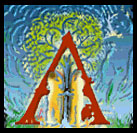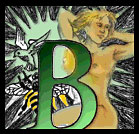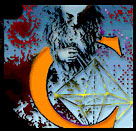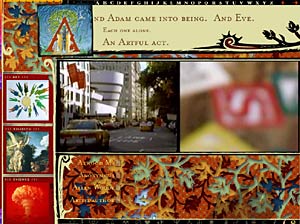| |
|
POUR
COMMANDER
|
|
• Faites parvenir votre commande par courriel en remplissant
le BON DE COMMANDE.
•
Une confirmation vous sera envoyée par courriel, avec un choix de modes de paiement.
•
Votre copie du cédérom vous sera envoyée
par la poste sur réception du paiement.
Version
anglaise
compatible
Macintosh ™ et Windows™
COÛT
Individus : 30 $
Institutions : 80 $
|
BIOGRAPHICAL
NOTE ON BARBARA
Barbara
Sternberg has been making (experimental) films since the mid-seventies.
Her films have been screened widely including Ontario Cinematheque and
Pleasure Dome in Toronto, The Museum of Modern Art in New York,George
Pompidou Centre in Paris, and are in the collections of the Art Gallery
of Ontario, and the National Gallery of Canada. Sternberg has also participated
in gallery exhibitions with mixed media installations and performance
art. She has been visiting artist at a number of Canadian universities
as well as the Universite d'Avignon and the Schoool of the Art Institute
of Chicago. She was co-founder of Struts gallery in Sackville,New Brunswick,
was a founding member of Pleasure Dome: Film Artists Exhibition Group
in Toronto and taught in Film and Visual Arts at York University. "Illuminations:
a Book of Letters" is her first Cdrom artwork. It was premiered at
Pleasure Dome and presented at the Festival de nouveau cinema et des nouveau
medias de Montreal. She is currently at work on a videotape and another
cdrom.
CREDITS
•
Author and Producer: Barbara Sternberg
• Film and Video: Barbara Sternberg
• Interface Design and Production: Michelle Gay
•
Letter Drawing: Rubyn Budd
•
Letter Inking: Michelle Gay
•
Programming: Richard Conroy
Funded
by
The Ontario Arts Council
|
On each page,
two video sequences with sound are edited side by side and play in a continuous
loop. Along the left side of the screen, three still images can be changed
by the viewer clicking on them. The multiple images on the page are arranged
so as to be reminiscent of both illuminated manuscripts and the computer
screen itself. Images will function differently than text exploiting the
more bodily nature of perception in contrast to the conceptual aspect
of language. Interconnections exist between the images and text on each
page and between pages, though the work does not have to be experienced
sequentially. Ideas relay throughout, unifying the work and making connections.
 While
encyclopeidic in approach, organized by the letters of the alphabet, the
Book Of Letters is not an encyclopedia. It focuses on and makes connections
between religion, art and science, three disciplines that inform so much
of contemporary life and interface in these times. The work in science
on the beginnings of the universe, on DNA/genomes, "blueprints for
human creation", and on fractals, the science of chaos, are ripe
with counterparts in Genesis and Apocalypse of the Bible and creation
myths of other cultures. Physicists speak of divine plans and the history
of art is full of sacred imagery. Art is regarded as a spiritual expression
by some, as a making of material objects by others. While
encyclopeidic in approach, organized by the letters of the alphabet, the
Book Of Letters is not an encyclopedia. It focuses on and makes connections
between religion, art and science, three disciplines that inform so much
of contemporary life and interface in these times. The work in science
on the beginnings of the universe, on DNA/genomes, "blueprints for
human creation", and on fractals, the science of chaos, are ripe
with counterparts in Genesis and Apocalypse of the Bible and creation
myths of other cultures. Physicists speak of divine plans and the history
of art is full of sacred imagery. Art is regarded as a spiritual expression
by some, as a making of material objects by others.  Computer
printouts of fractals are seen as art, and artists are engaged with technology
and scientific concepts. In all three disciplines the question of reality,
its perception and its representation, looms. The Book works with contradictions
and paradoxes seeing these as opposing poles of a unified whole. Due to
its interactive nature, the CDRom can offer a great deal of textual material. Computer
printouts of fractals are seen as art, and artists are engaged with technology
and scientific concepts. In all three disciplines the question of reality,
its perception and its representation, looms. The Book works with contradictions
and paradoxes seeing these as opposing poles of a unified whole. Due to
its interactive nature, the CDRom can offer a great deal of textual material.
 The
imagery in the videos comes from daily life, what's around us: the morning
light in the kitchen, items on a bedroom dresser and repetitive motions
such as patting, hammering, rowing, kneading. Also the reverie-inducing
motions of flames flickering, leaves fluttering, waves lapping. Included
are images that surround our daily lives, that form the lived context,
images from newspapers, T.V. and movies. The
imagery in the videos comes from daily life, what's around us: the morning
light in the kitchen, items on a bedroom dresser and repetitive motions
such as patting, hammering, rowing, kneading. Also the reverie-inducing
motions of flames flickering, leaves fluttering, waves lapping. Included
are images that surround our daily lives, that form the lived context,
images from newspapers, T.V. and movies.
In this piece, with images paired on each page, certain connections, synchronous
moments, will be experienced between the dual images. References in text
to something previously imaged, will bind the work together over the twenty-six
'pages'. Important images and concepts in this regard are fire, hand,
language (communication). Rhythmic pulsing makes equivalences between
disparate images; think of hammering, kneading, rowing, walking.
 This
piece works with the idea of the union of opposites. The image of a potter
creating a vessel on the wheel from raw clay contains both nature and
culture; male and female are conjoined in procreation; fire is destructive
and nurturing (love and hate). Fire forges links between science and religion
which are often thought of as opposing conceptual frameworks and, via
alchemy, between science and art. This
piece works with the idea of the union of opposites. The image of a potter
creating a vessel on the wheel from raw clay contains both nature and
culture; male and female are conjoined in procreation; fire is destructive
and nurturing (love and hate). Fire forges links between science and religion
which are often thought of as opposing conceptual frameworks and, via
alchemy, between science and art.
The relationship between language and experience is acknowledged: the
analytic, conceptual aspects of language and the bodily, felt nature of
visuals. In the Book, the main text uses concepts, abstract nouns such
as 'love', 'hell', 'creation', 'presence'. The images, apprehended visually,
bodily make the concepts tangible, felt - hand carressing cat, men wrestling,
the raw material of clay being formed into a vessel - (this last image
might be seen to reference the Biblical image of man as molded by god
and at death returned to the mud).
|
 The
CD-Rom ILLUMINATIONS: A BOOK OF LETTERS models book form, specifically,
illuminated manuscripts. The twenty-six 'pages' or screens, one for
each letter of the alphabet, contains video material put into quick-time
movies, graphics, and still images and text with interactive potential.
The
CD-Rom ILLUMINATIONS: A BOOK OF LETTERS models book form, specifically,
illuminated manuscripts. The twenty-six 'pages' or screens, one for
each letter of the alphabet, contains video material put into quick-time
movies, graphics, and still images and text with interactive potential.
 While
encyclopeidic in approach, organized by the letters of the alphabet, the
Book Of Letters is not an encyclopedia. It focuses on and makes connections
between religion, art and science, three disciplines that inform so much
of contemporary life and interface in these times. The work in science
on the beginnings of the universe, on DNA/genomes, "blueprints for
human creation", and on fractals, the science of chaos, are ripe
with counterparts in Genesis and Apocalypse of the Bible and creation
myths of other cultures. Physicists speak of divine plans and the history
of art is full of sacred imagery. Art is regarded as a spiritual expression
by some, as a making of material objects by others.
While
encyclopeidic in approach, organized by the letters of the alphabet, the
Book Of Letters is not an encyclopedia. It focuses on and makes connections
between religion, art and science, three disciplines that inform so much
of contemporary life and interface in these times. The work in science
on the beginnings of the universe, on DNA/genomes, "blueprints for
human creation", and on fractals, the science of chaos, are ripe
with counterparts in Genesis and Apocalypse of the Bible and creation
myths of other cultures. Physicists speak of divine plans and the history
of art is full of sacred imagery. Art is regarded as a spiritual expression
by some, as a making of material objects by others.  Computer
printouts of fractals are seen as art, and artists are engaged with technology
and scientific concepts. In all three disciplines the question of reality,
its perception and its representation, looms. The Book works with contradictions
and paradoxes seeing these as opposing poles of a unified whole. Due to
its interactive nature, the CDRom can offer a great deal of textual material.
Computer
printouts of fractals are seen as art, and artists are engaged with technology
and scientific concepts. In all three disciplines the question of reality,
its perception and its representation, looms. The Book works with contradictions
and paradoxes seeing these as opposing poles of a unified whole. Due to
its interactive nature, the CDRom can offer a great deal of textual material. The
imagery in the videos comes from daily life, what's around us: the morning
light in the kitchen, items on a bedroom dresser and repetitive motions
such as patting, hammering, rowing, kneading. Also the reverie-inducing
motions of flames flickering, leaves fluttering, waves lapping. Included
are images that surround our daily lives, that form the lived context,
images from newspapers, T.V. and movies.
The
imagery in the videos comes from daily life, what's around us: the morning
light in the kitchen, items on a bedroom dresser and repetitive motions
such as patting, hammering, rowing, kneading. Also the reverie-inducing
motions of flames flickering, leaves fluttering, waves lapping. Included
are images that surround our daily lives, that form the lived context,
images from newspapers, T.V. and movies. This
piece works with the idea of the union of opposites. The image of a potter
creating a vessel on the wheel from raw clay contains both nature and
culture; male and female are conjoined in procreation; fire is destructive
and nurturing (love and hate). Fire forges links between science and religion
which are often thought of as opposing conceptual frameworks and, via
alchemy, between science and art.
This
piece works with the idea of the union of opposites. The image of a potter
creating a vessel on the wheel from raw clay contains both nature and
culture; male and female are conjoined in procreation; fire is destructive
and nurturing (love and hate). Fire forges links between science and religion
which are often thought of as opposing conceptual frameworks and, via
alchemy, between science and art.